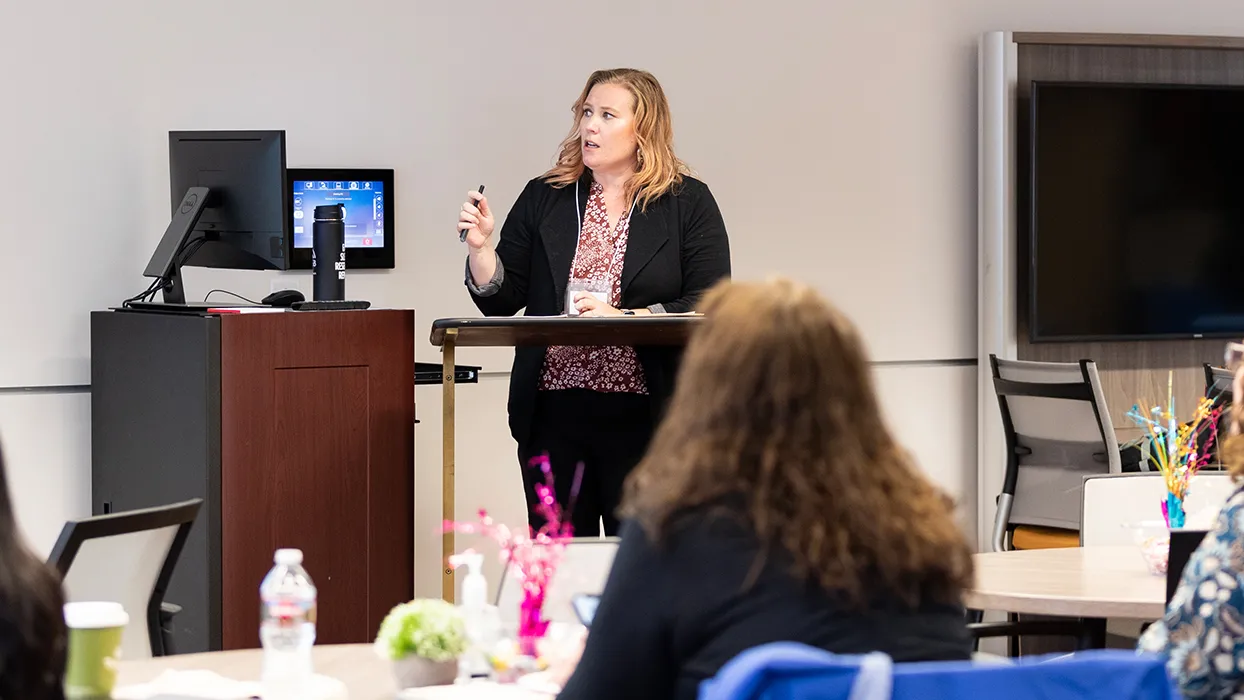Amanda Mattox | Office of Strategic Communication | (909) 537-3008 | amanda.mattox@csusb.edu

Educators from Cal State San Bernardino, Victor Valley College, Crafton Hills College, Cal Poly Pomona and San Bernardino Valley College gathered in mid-April on the CSUSB campus to learn about research findings focusing on racial equity in early childhood education.
Held at the CSUSB Faulty Center for Excellence, the event was hosted by Amy van Schagen, associate professor in the CSUSB child development department who served as the project’s principal investigator.
Van Schagen, who examines racial, ethnic and cultural diversity; teacher development and work environments; and access to high quality early childhood education for marginalized groups, works with Quality Start San Bernardino County, a nonprofit organization working to raise the quality of early learning programs in the county. Together, they decided to dive deeper into this topic.
“This research really came out of a desire for our Quality Start San Bernardino to do research and look at what racial equity looks like within our county with our early childhood workforce,” van Schagen said during the meeting, “That was something that they really valued and felt was important.”
Through surveys, open-ended responses as well as interviews, van Schagen and her team of student research assistants gathered information about perceived experiences with racism within early childhood education the San Bernardino County workplace. They gathered information from childcare teachers, assistant teachers and directors who work with infants to children up to 5 years old.
She thanked First 5 San Bernardino, a government organization that serves children prenatal through age 5 and their families, for “graciously (setting) up to provide funding for us to be able to research.” In 2022, First 5 San Bernardino awarded the Institute for Child Development and Family Relations at CSUSB nearly $168,000 to research racial equity in early childhood education.
Christina Hassija, interim dean of the CSUSB College of Social and Behavioral Sciences, which houses the child development department, thanked van Schagen for coordinating the event and research “to discuss a really important area of early childhood education specifically as it relates to diversity, equity and inclusion.”
“All of us in the room are educators, whether that applies to children or young adults,” Hassija said to the attendees. “I think we’re all committed and responsible to ensuring that both children and our adult students have equitable access to educational opportunities and resources, and that our faculty have access to support, to ensure that we provide equitable education and curriculum that is also tailored to the needs of the students that we serve.”
Van Schagen said that they had a total of 250 participants, with 180 identifying as Black, Indigenous, People of Color (BIPOC) and 70 identifying as white only.
Van Schagen and her team asked: Do BIPOC early childhood educators experience racial discrimination in the workplace? At the structural level? At an interpersonal level?
“With regards to structural discrimination,” van Schagen said, “we do see that it’s present both at the salary level or wage level as well as work time support pieces.”
They found that BIPOC teachers and directors make less than their white colleagues in similar positions and report receiving less paid vacation time, planning time and sick leave. They also found that racial discrimination is present at the interpersonal level and that microaggression is a persistent issue.
“The messages that (people of color) are getting are that white teachers’ words are more valuable than theirs,” van Schagen said while discussing the findings. “And I think that’s something that has resonated with me in thinking how much fatigue that must add on to the load that BIPOC teachers and directors are already experiencing.”
Van Schagen and her team also found that there is consensus that topics of race and racism/bias should be discussed with young children; that there is a disconnect between recognizing its importance and its integration; that white teachers are less comfortable discussing these topics and do so less frequently; and that colorblindness and whiteness are present.
They even looked into the materials that are available in early childhood classrooms, such as developmentally appropriate books around race and/or racism.
“I think it’s really important for us as institutes of higher (education) to think about how these results impact our programs, things that we may want to shift or consider within our programs,” van Schagen said to the attendees. “I know you all have strong child development programs, and so we can all learn from each other.”
With these findings, the goal is for institutes of higher education to continue to meet and discuss how topics associated with racial equity are or can be integrated into degree programs. The plan is to also create a higher education stipend program so colleges in the area can have time and funding to implement findings from the study; expand the racial equity in early childhood education research study; and design a racial equity in early childhood education certificate program that can be college credit.